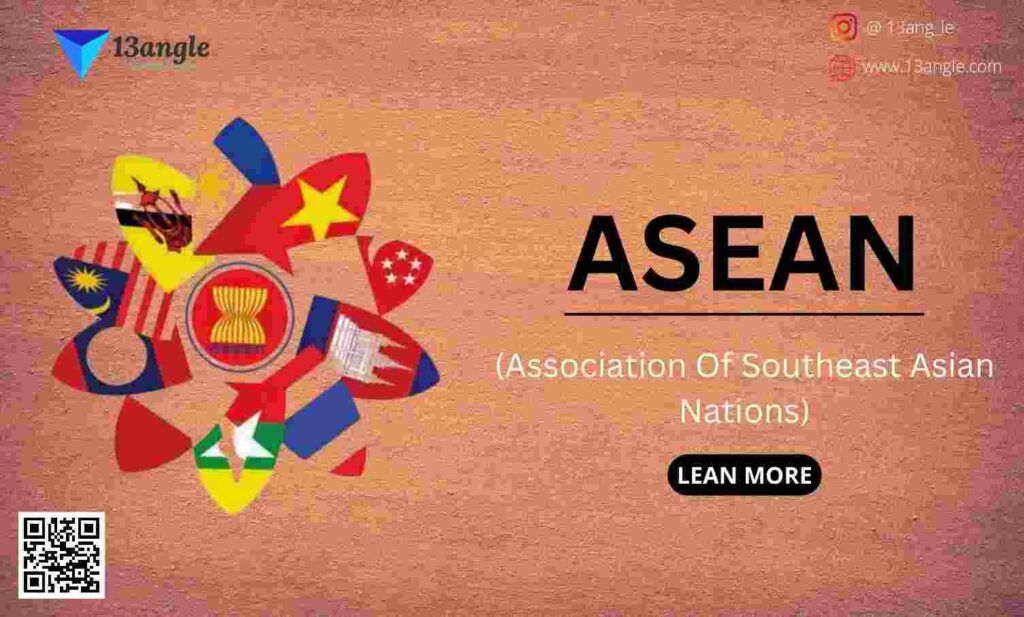- Umang Sagar
- Organisation, Recent article
Association of Southeast Asian Nations (ASEAN)
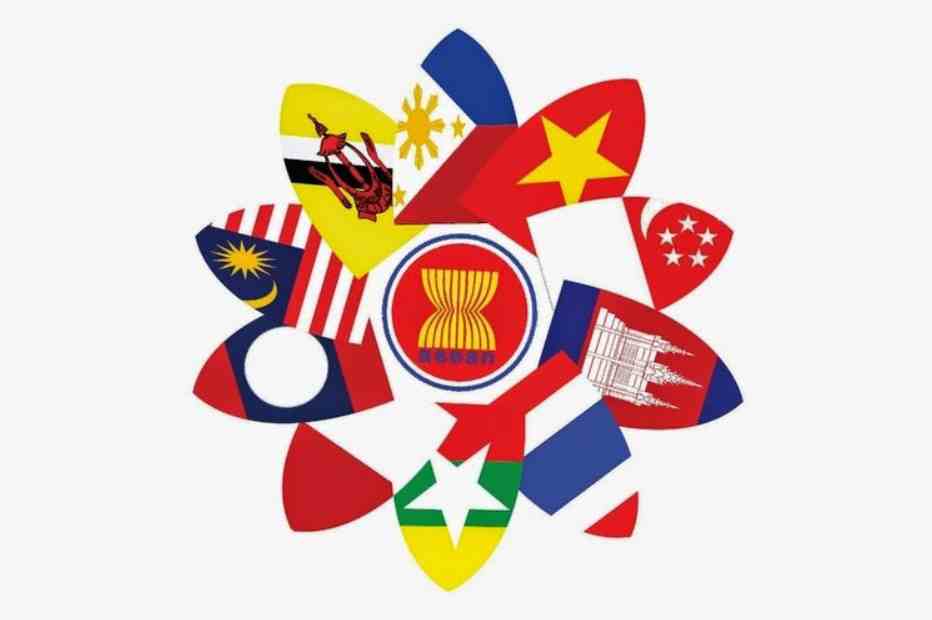
Introduction
The Association of Southeast Asian Nations or ASEAN is a regional organization that brings together the developing nations of Southeast Asia to bring about social, economic and cultural growth through joint endeavors in the spirit of equality and partnership.
The founding members of the ASEAN were namely;
- Indonesia,
- Malaysia,
- Philippines,
- Singapore and
- Thailand.
- The group plays a central role in Asian economic regeneration and is a crucial bloc for regional cooperation and diplomacy.
Origin Of ASEAN
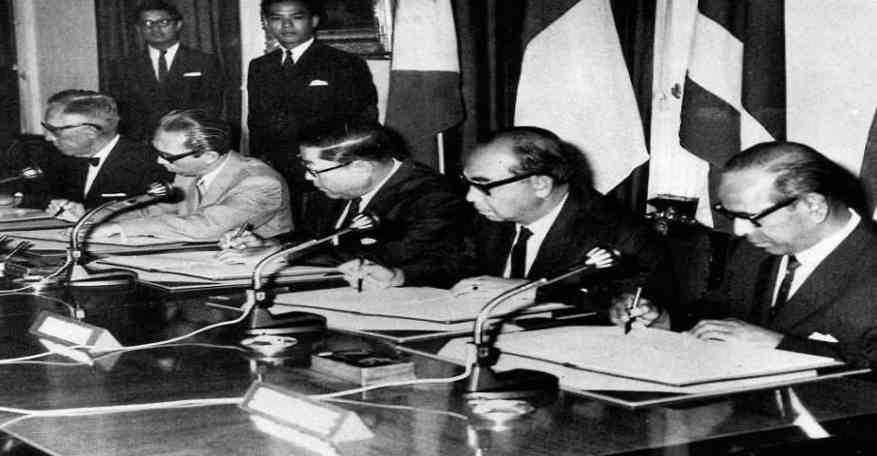
After the end of the Second World War, a power vacancy was created in the work political scenario. This void was filled by two emerging power holders; the USA and the erstwhile USSR (United Socialist Soviet Union). What played out for the next few decades was ideological warfare and a Cold War. While the USA believed in a free market and capitalism, USSR believed in Socialism and a closed economy.
While most of the countries struggled to keep up with the subjugation of these power blocs, many newly independent countries like those of Southeast Asia chose to form their independent foreign policy.
The ASEAN was formally formed on 8th August 1967 by the five founding members at the Department of Foreign Affairs building in Bangkok. The members signed the Treaty of Amity and Cooperation in Southeast Asia.
These newly independent nations did not want to be a part of bloc politics and instead formed a regional bloc that was based on the principle of “mutual respect and non-interference in other countries’ affairs.”
The members of the ASEAN at present are -Brunei Darussalam, Indonesia, Laos, Malaysia, Myanmar, Philippines, Singapore, Thailand and Vietnam. It has one observer state- Papua New Guinea.
Aims And Objectives Of ASEAN
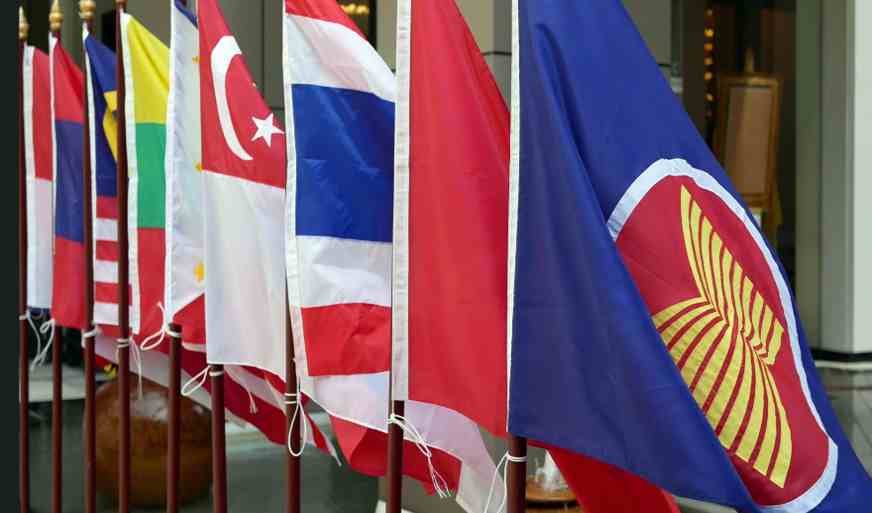
As set out in the official ASEAN Declaration, the aims and objectives of ASEAN are as follows-
To accelerate the economic growth, social progress, and cultural development in the region through joint endeavors in the spirit of equality and partnership to strengthen the foundation for a prosperous and peaceful community of Southeast Asian Nations;
To promote regional peace and stability through abiding respect for justice and the rule of law in the relationship among countries of the region and adherence to the principles of the United Nations Charter;
To promote active collaboration and mutual assistance on matters of common interest in the economic, social, cultural, technical, scientific, and administrative spheres;
To aid each other in the form of training and research facilities in the educational, professional, technical, and administrative spheres;
To collaborate more effectively for the greater utilization of their agriculture and industries, the expansion of their trade, including the study of the problems of international commodity trade, the improvement of their transportation and communications facilities, and the raising of the living standards of their peoples;
To promote Southeast Asian studies; and
To maintain close and beneficial cooperations with existing international and regional organizations with similar aims and purposes and explore all avenues for even closer cooperation among themselves.
Fundamental Principles Of ASEAN
The ASEAN commits to a few principles that are supposed to be followed and respected by all the member states.
In their relations with one another, the ASEAN Member States have adopted the following fundamental principles, as contained in the Treaty of Amity and Cooperation in Southeast Asia (TAC) of 1976.
The principles are as follows-
- Mutual respect for the independence, sovereignty, quality, territorial integrity, and national identity of all nations;
- The right of every state to lead its national existence free from external interference, subversion, or coercion;
- Non-interference in the internal affairs of one another;
- Settlements of differences or disputes in a peaceful manner;
- Renunciation of the threat or use of force; and
- Effective cooperation among themselves.
Organizational Structure Of ASEAN
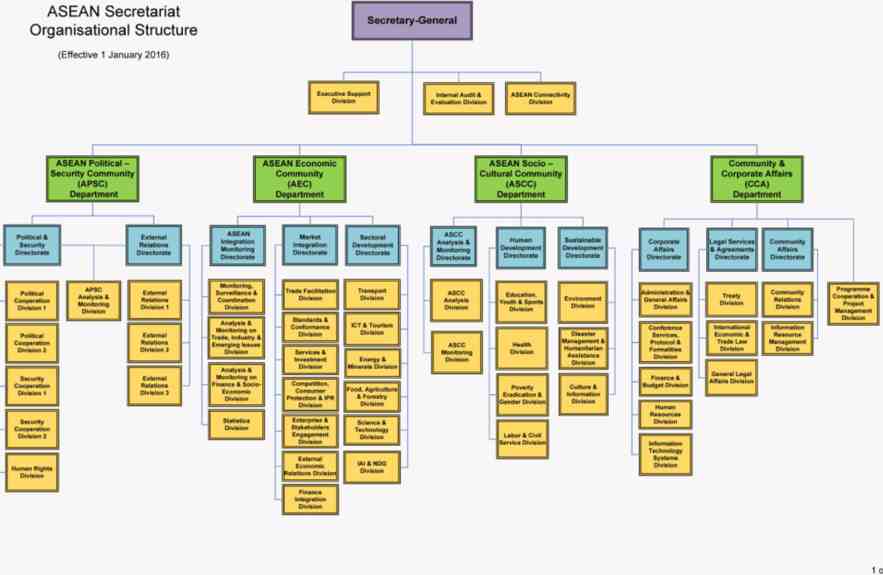
The organization of the entire ASEAN is divided and subdivided into several categories each under a specific area.
The ASEAN Secretariat was established on 24th February 1976 by the Foreign Ministers of ASEAN. The Agreement on the Establishment of the ASEAN Secretariat stated that the basic mandate of the ASEAN Secretariat is to “provide for the greater efficiency in the coordination of ASEAN projects and activities.”
The composition of the ASEAN Secretariat may be elaborated as follows-
- Secretary-General,
- 3 Bureau Directors,
- A Foreign Trade Officer
- An Economic Relations Officer,
- An Administrative Officer,
- A Public Information Officer and
- An Assistant to the Secretary-General.
There were multiple amendments in the ASEAN Charter that changed the number of officers according to the needs of the situation and the addition of new member states.
- There are several departments too, working under the ASEAN that deal with various activities such as Environmental, Cultural, Disaster Management, and Humanitarian Assistance.
- The subdivisions of the Departments are as follows-
1. ASEAN Political-security Community Department
- Political and security directorate
- Political Cooperation Division 1 and 2
2. ASEAN Economic Community Department (AEC Department)
- ASEAN Integration Monitoring Directorate
- Market Integration Directorate
- Sectoral Development Directorate
3. ASEAN Socio-cultural Community Department (CCA)
- ASCC Analysis Division
- Human Development Directorate
- Sustainable Development Directorate
4. Community And Corporate Affairs Department (CCA Department)
- Corporate Affairs Directorate
- Community Affairs Directorate
- Legal Services and Agreement Directorate
- Program Cooperation and Project
Achievements Of The ASEAN
On 8th August 2019, the Association of Southeast Asian Nations turned 52 years old. Marking the occasion is the launch of the new ASEAN secretariat Building in Jakarta to house member representatives and secretariat staff.
This was done to celebrate the milestones of ASEAN and to include the new members as well.
- ASEAN has done a notable job and has been successful to realize its principles and aims.
Firstly, ASEAN has preserved peace and stability in the region. In 2015, ASEAN established the ASEAN Community, which consists of a political and security community, an economic community, and a social-cultural community. This was a substantial step towards regional integration. The Southeast Asian region consists of many nations with distinct cultures and communities so maintaining peace was a real challenge considering all attained their independence in recent history. So economic and cultural cooperation was needed among them for regional development.
ASEAN has also adopted two conventions to counter transnational crime; the ASEAN Convention on Counter Terrorism in 2007 and the ASEAN Convention against Trafficking in Persons in 2015. ASEAN has established the ASEAN Defense Ministers Meeting for intra-ASEAN defense cooperation and military cooperation between ASEAN and its external partners.
ASEAN’s political and security achievements contribute positively to economic development. The ASEAN Economic Community (AEC) has established a single and open market with many economic opportunities since 2015. For business actors, the AEC decreases costs, supports the flow of free goods and increases investments. ASEAN is working to integrate the association with the world economy and has developed free-trade agreements with several partners including Australia, China, Japan, India, South Korea and New Zealand.
Recently, ASEAN is still working on a mega trade pact known as the “Regional Comprehensive Economic Partnership” with the above partners. The RCEP is the largest economic agreement that will progressively reduce trade tariffs and help ease business. RCEP is currently in force from 1st January 2022. Its partners are Australia, China, India, Japan, NEW Zealand, and the Republic of Korea. It has produced a GDP of US$23.6 trillion and contains a population of 2.3 billion.
ASEAN is focused on building socio-cultural relationships among member states through the ASEAN Socio-Cultural Community, which positively contributed to social progress by reducing the proportion of people living on less than US$1.25 a day from one in every two persons to one in every eight within two decades and minimizing infant and maternal mortality in the region. Life expectancy in ASEAN has risen from 55.6 years in 1969 to 70.9 in 2016 (ASEAN Secretariat, 2018).
The ASEAN Socio-Cultural Community also attempts to build ASEAN’s identity and character, both of which are people-centered. One another project, the ASEAN Co-ordinating Centre for Humanitarian Assistance on Disaster Response and Management (AHA Centre), is seeking to develop regional disaster risk management and climate change adaptation capabilities (ASEAN Secretariat, 2018). This was done keeping in mind the geographical and disaster-prone areas of the Southeast.
The ASCC (ASEAN Socio-Cultural Community) Blueprint 2025 was regarded as an exceptional guideline for fostering stronger bonds between neighboring states. The Blueprint was adopted by the ASEAN leaders at the 27th ASEAN Summit on 22nd November 2015 in Kuala Lumpur, Malaysia.
Initially, it was seen that the 5 founding members were making the most development and progress after admitting several new members. It was realized at the Summit meeting of Singapore in 2000. So, it adopted a special program for bridging this gap called the “Initiative for ASEAN Integration” or the IAI. The initiative aims to provide a framework for regional cooperation through which the more developed ASEAN member states could help those member states who need it. Following the leader’s decision, in July 2001, the ASEAN Foreign Ministers adopted the Hà Nội Declaration on Narrowing the Development Gap for closer ASEAN integration.
Focus Areas Of ASEAN
The ASEAN was established to help with the collective development of the Southeast region as they were mostly newly independent nation-states.
But, with time they have all emerged as fast-developing states with thriving economies and democracy. Singapore is now the most developed country in Asia with other Southeast Asian states generating huge revenues from the tourism industry and exporting raw materials.
The ASEAN member states are now focusing on Cross-Sectoral Initiatives to bring unity to their ventures and distribute services across.
Kuala Lumpur Declaration 2015 decided that the IAI Work Plan III and the ASEAN Connectivity 2025 adopted in 2016 shall be an integral part of the ASEAN 2025, and other cross-sectoral issues and coordination should also be continuously enhanced and strengthened.
Another area where ASEAN has invested its resources is in the ASEAN Smart Cities Network (ASCN). ASCN is a collaborative platform where cities from the top ASEAN Member States (AMS) work towards the common goal of smart and sustainable urban development. Some of the ASCN Cities were Kuala Lumpur, Jakarta, Manila, Singapore, Bangkok, Hanoi, and Ho Chi Minh City.
Challenges Of ASEAN
Just like any other emerging regional organization, ASEAN faces its fair share of challenges. With Myanmar emerging as a junta-style government, there has been a lot of criticism, especially from the Western media and government centered around the working of the ASEAN.
- Some of the most viable challenges faced by ASEAN are listed as follows.
Enlargement has been seen by ASEAN’s senior leaders as a way of adding to the association’s “weight” and credibility as a grouping able to represent the whole of Southeast Asia. However, enlargement also possess the question of whether ASEAN can accommodate new members with substantial internal political problems and keep the community of interests that it has developed over a period of 30 years.
ASEAN faced a ‘complex regional security environment in the 1990s. China’s economic growth has benefited the whole East Asian region but its rise in regional prominence has produced uncertainties. To contribute positively to post-Cold War security in East Asia, ASEAN has established the ASEAN Regional Forum to engage the Asia Pacific major powers in dialogue and confidence-building measures. ASEAN now faces the challenge of maintaining its leading role as the organizer of this important focus for security discussions.
ASEAN’s internal cohesion may also be affected by the issue of leadership transition and whether ASEAN’s emerging leaders will continue to give the development of relationships among members the high priority that has in the past been assigned to this by the group’s founders and the senior leader.
The number one focus of the ASEAN leaders has been to make Southeast Asia an attractive focus for investment and trade. To implement it, the ASEAN Free Trade Area (AFTA) has been developed for liberalizing investment policies. However, enlargement has been an obstacle in easing this economic policy as too many members put forward different views. This makes the decision-making process lengthy and unfruitful.
ASEAN Summits
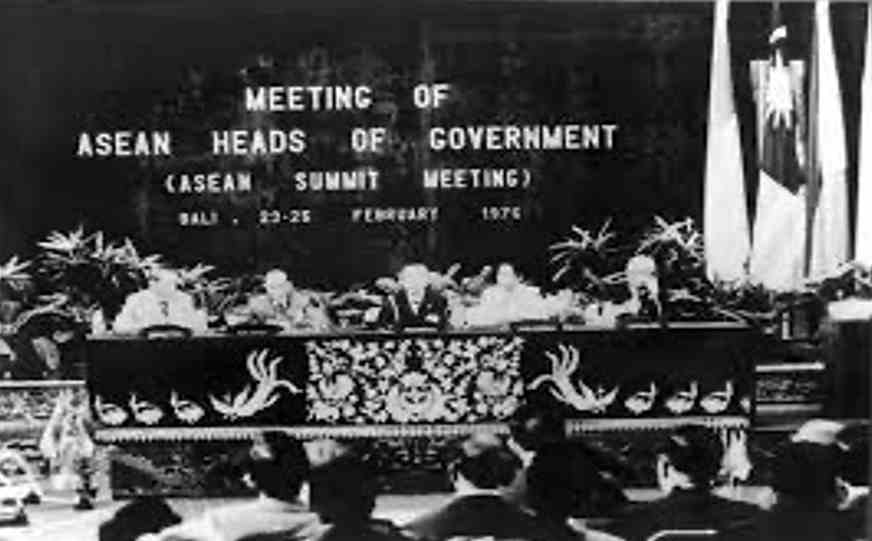
The ASEAN had its first summit on 23rd February 1976 in Bali, Indonesia, and was presided over by then President Soeharto. At this summit, the Treaty of Amity and Cooperation in Southeast Asia (TAC) was signed by the founding members of ASEAN. The principles were declared for the first time that the member states were to follow.
Following this, the ASEAN members met once every year to discuss key issues and to admit new members. The 2nd ASEAN Summit was held in Kuala Lumpur in 1977. A Declaration at the 9th ASEAN Summit was passed which stated the three most important pillars of the ASEAN Framework, namely the “political and security cooperation, economic cooperation and sociology-cultural cooperation.
The 38th and 39th ASEAN Summit was held on 26th October 2021 in Bandar Seri Begawan under the leadership of its member state, Brunei Darussalam. It was chaired by His Majesty Haji Ali Hassanal Bolkiah, Sultan and Yang Di-Petruan of Brunei Darussalam. The Summit reaffirmed its core value to create a harmonious environment and to make more opportunities for all member states to grow and thrive.
The 40th and 41st ASEAN Summit is scheduled to be held from 10th to 13th November 2022 in Cambodia, one of its member states.
India’s Role In ASEAN
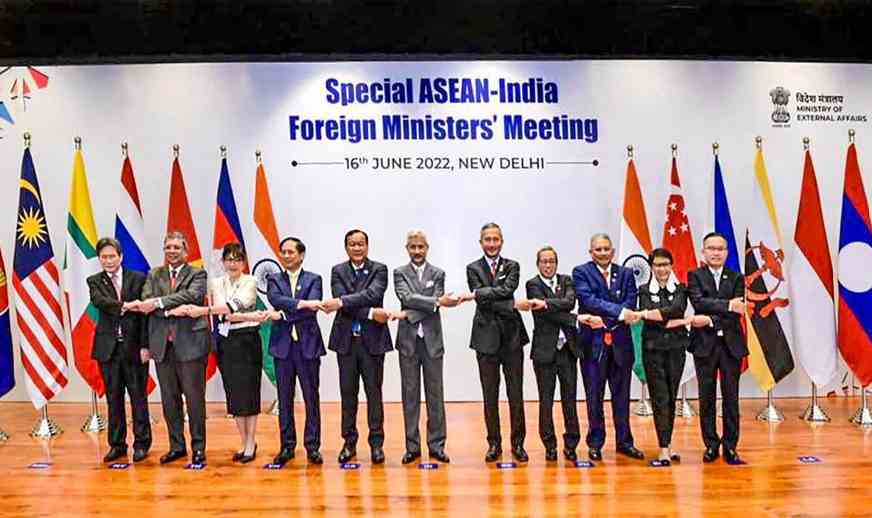
India is not a member of the ASEAN as its location is South Asia and not specifically Southeast Asia. However, India being a key player in Asia is actively engaged in bi-lateral dialogue with the ASEAN. India is one strategic partner of ASEAN.
According to a report on the Indian External Affairs website, India began formal engagement with ASEAN in 1992 as the Sectoral Dialogue Partner and consequently Dialogue Partner in 1996.
A Commemorative Summit Meeting was held in New Delhi from 20th to 21st December 2012 of this dialogue.
The 30th-year Commemoration was designated as the India-ASEAN Friendship Year by the leaders in 2021.
Three funds have been created to foster sectoral development. The Funds are as follows-
- ASEAN-India Cooperation Fund (AIF)
- ASEAN-India Green Fund (AIGF) and
- ASEAN-India Science and Technology Development Fund (AISTDF).
Future Of ASEAN
According to a PwC (PricewaterhouseCoopers) report, ASEAN has not only managed to double its membership but has successfully survived the financial crisis in 2008.
However, recent challenges like weak workforce productivity, slow economic growth, and over-dependence on external trade have posed a dent in the working of the ASEAN. To overcome the shortcomings, PwC has recommended the following steps-
- Take more proactive steps to attract investments,
- Develop the institutions and
- Evolve people and technological capabilities.
There is an acute shortage of skilled laborers resulting in an unequal pay scale. A skilled worker in Singapore earns 3x its counterpart in neighbouring countries like Cambodia or Laos. As a result, Singapore attracts more skilled workers than its fellow members creating an unequal development and standard of life.
China’s colossal economic growth poses serious competition to the ASEAN Economy.
- Despite the shortcomings, ASEAN has an economy of $2.3 trillion and is estimated to become the 4th largest economy by 2030.
Conclusion
Quite unique to Asia, ASEAN has managed to forge a sense of community among its member states and has managed to not let inter-state disputes get out of hand. Formed initially with the aim of countering the spread of communism in the region, the organization has continued to do well even though the threat of communism has long since evaporated.
ASEAN must continue to put continuous efforts to revive itself and emerge as a strong contender in global politics and economy.
Top 13 Interesting Facts About ASEAN
ASEAN has a population of 600 million and a geographical area of 1.7 million square miles.
ASEAN has a combined GDP of $2.5 trillion and is estimated to become the 4th largest economy by 2030.
ASEAN is the 4th largest exporting region and accounts for 7% of the total global export.
Till 2013, there are 74 headquarters of companies listed in Forbes Global.
There are 227 world companies in the ASEAN threshold and have a revenue of more than $1 billion.
The cultural composition of ASEAN is the most diverse and dense than any other economy.
ASEAN has almost 20% of the animal and plant species in its lakes, forests, and mountains; making it the most diverse in terms of flora and fauna.
The ASEAN Flag has 4 colors – red, blue, white, and yellow. Each Color represents a theme.
The ASEAN is home to 8.7% of the total world population.
Almost 49% of the ASEAN population lives in urban areas.
There is a massive technological development with 147.2 mobile phones per 100 persons.
The production of food grains in the ASEAN region brings food security to the entire world.
Over 100 million laborers have joined the ASEAN region in the wonky last 20 years.
FAQs
ASEAN was founded by the states of Indonesia, Malaysia, Singapore, Thailand and the Philippines. Their Foreign Ministers namely; Adam Malik, Tun Abdul Razak, S.Rajaratnam, Thanat Khomeini and Narciso R. Ramos respectively.
The motto of ASEAN as reflected in its 2022 summit was “One Vision, One Identity, One Community.”
ASEAN was created on 8th August 1967.
ASEAN has three pillars namely;
- The ASEAN Political-Security Community (APSC)
- The ASEAN Economic Community (AEC)
- The ASEAN Socio-Cultural Community (ASCC).
The headquarters of ASEAN is in Jakarta, Indonesia.
The only landlocked country of ASEAN is Laos.
ASEAN is currently presided over by Lim Jock Hoi of Indonesia.
Brunei Darussalam has the smallest population among all the ASEAN states.
ASEAN aims to attract better investment opportunities in the Southeast and make it a stable and competitive market.
Yes, ASEAN countries have tariff rates.
ASEAN stands for Association of Southeast Asian Nations.
The main objective of ASEAN is to accelerate economic, social and cultural development in the Southeast.
The ASEAN Summit of 2023 will be hosted by Indonesia.




